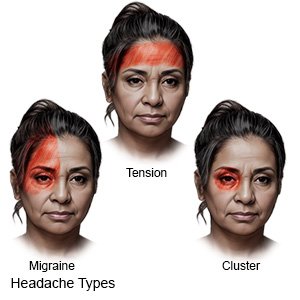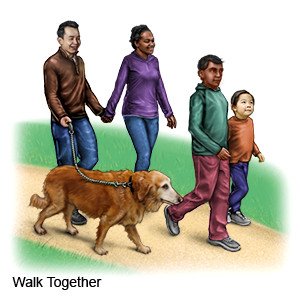Migraine Headache
Medically reviewed by Drugs.com. Last updated on Aug 4, 2025.
AMBULATORY CARE:
A migraine headache
is a severe headache. The pain can be so severe that it interferes with your daily activities. A migraine can last a few hours up to several days. The exact cause of migraines is not known. A family history of migraines increases your risk. Your risk is also higher if you are a woman or take medicines such as estrogen or a vasodilator.
Common warning signs include the following:
Warning signs usually start 15 to 60 minutes before the headache:
- Visual changes (auras), such as blurred vision, temporary blind or bright spots, lines, or hallucinations
- Unusual tiredness or frequent yawning
- Tingling in an arm or leg
Signs and symptoms of a migraine headache:
A migraine headache usually begins as a dull ache around the eye or temple. The pain may get worse with movement. You may also have the following:
- Pain in your head that may increase to the point that you cannot do everyday activities
- Pain on one or both sides of your head
- Throbbing, pulsing, or pounding pain in your head
- Nausea and vomiting
- Sensitivity to light, noise, or smells
 |
Call your local emergency number (911 in the US) or have someone call if:
- You feel like you are going to faint, you become confused, or you have a seizure.
Seek care immediately if:
- You have a headache that seems different or much worse than your usual migraine headache.
- You have a severe headache with a fever or a stiff neck.
- You have new problems with speech, vision, balance, or movement.
Related medications
Call your doctor or neurologist if:
- You have a fever.
- Your migraines interfere with your daily activities.
- Your medicines or treatments stop working.
- You have questions about your condition or care.
Treatment:
Migraines cannot be cured. The goal of treatment is to reduce your symptoms. Take medicine as soon as you feel a migraine begin, or as directed. The following may be used to manage migraines:
- Medicines may be given to prevent or treat migraines. Take medicine to prevent migraines as soon as you feel a migraine begin, or as directed. Your healthcare provider may recommend any of the following:
- Migraine medicines are used to help prevent or stop a migraine.
- NSAIDs help decrease swelling and pain or fever. This medicine is available with or without a doctor's order. NSAIDs can cause stomach bleeding or kidney problems in certain people. If you take blood thinner medicine, always ask your healthcare provider if NSAIDs are safe for you. Always read the medicine label and follow directions.
- Acetaminophen decreases pain and fever. It is available without a doctor's order. Ask how much to take and how often to take it. Follow directions. Read the labels of all other medicines you are using to see if they also contain acetaminophen, or ask your doctor or pharmacist. Acetaminophen can cause liver damage if not taken correctly.
- Antinausea medicine may be given to calm your stomach and to help prevent vomiting. This medicine can also help relieve pain.
- Cognitive behavior therapy (CBT) can help you learn ways to manage and prevent migraines. A therapist can teach you to relax and to reduce stress. You may learn ways to create healthy nutrition, activity, and sleep habits to prevent migraines. The therapist can also help you manage conditions that can affect migraines, such as anxiety or depression.
Treatment options
The following list of medications are related to or used in the treatment of this condition.
Common triggers for a migraine include the following:
- Stress, eye strain, oversleeping, or not getting enough sleep
- Hormone changes in women from birth control pills, pregnancy, menopause, or during a monthly period
- Skipping meals, going too long without eating, or not drinking enough liquids
- Certain foods or drinks such as chocolate, hard cheese, alcohol, or drinks that contain caffeine
- Foods that contain gluten, nitrates, MSG, or artificial sweeteners
- Sunlight, bright or flashing lights, loud noises, smoke, or strong smells
- Heat, humidity, or changes in the weather
Manage your symptoms:
- Rest in a dark, quiet room. This will help decrease your pain. Sleep may also help relieve the pain.
- Apply ice to decrease pain. Use an ice pack, or put crushed ice in a plastic bag. Cover the ice pack with a towel and place it on your head where it hurts for 15 to 20 minutes every hour.
- Apply heat to decrease pain and muscle spasms. Use a small towel dampened with warm water or a heating pad, or sit in a warm bath. Apply heat on the area for 20 to 30 minutes every 2 hours. You may alternate heat and ice.
- Keep a migraine record. Write down when your migraines start and stop. Include your symptoms and what you were doing when a migraine began. Record what you ate or drank for 24 hours before the migraine started. Keep track of what you did to treat your migraine and if it worked.
Prevent another migraine headache:
- Prevent a medicine overuse headache. Take pain medicines only as long as directed. A medicine may be limited to a certain amount each month. Your healthcare provider can help you create a plan so you get a safe amount each month. Blood pressure medicine, antidepressants, or antiseizure medicine may be used to prevent migraines. This can help lower the amount of migraine medicine you need.
- Do not smoke. Nicotine and other chemicals in cigarettes and cigars can trigger a migraine and also cause lung damage. Ask your healthcare provider for information if you currently smoke and need help to quit. E-cigarettes or smokeless tobacco still contain nicotine. Talk to your healthcare provider before you use these products.
- Do not drink alcohol. Alcohol can trigger a migraine. It can also interfere with the medicines used to treat your migraine.
- Be physically active. Physical activity, such as exercise, may help prevent migraines. Talk to your healthcare provider about the best activity plan for you. Try to get at least 30 minutes of physical activity on most days.

- Manage stress. Stress may trigger a migraine. Learn new ways to relax, such as deep breathing.
- Follow a sleep schedule. Go to bed and get up at the same time each day.
- Eat a variety of healthy foods. Healthy foods include fruit, vegetables, whole-grain breads, low-fat dairy products, beans, lean meats, and fish. Do not have foods or drinks that trigger your migraines.

- Drink more liquids to prevent dehydration. Your healthcare provider can tell you how much liquid to drink each day and which liquids are best for you.
Follow up with your doctor or neurologist as directed:
Bring your migraine record with you. Write down your questions so you remember to ask them during your visits.
© Copyright Merative 2025 Information is for End User's use only and may not be sold, redistributed or otherwise used for commercial purposes.
The above information is an educational aid only. It is not intended as medical advice for individual conditions or treatments. Talk to your doctor, nurse or pharmacist before following any medical regimen to see if it is safe and effective for you.
Learn more about Migraine Headache
Treatment options
Care guides
Symptoms and treatments
Medicine.com guides (external)
Further information
Always consult your healthcare provider to ensure the information displayed on this page applies to your personal circumstances.
